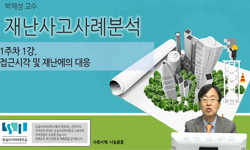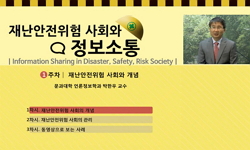In modern society, people live a more abundant life than they did in previous times primarily because of the advances in science and information technology. However, global warming and other environmental problems trigger natural disasters beyond huma...
http://chineseinput.net/에서 pinyin(병음)방식으로 중국어를 변환할 수 있습니다.
변환된 중국어를 복사하여 사용하시면 됩니다.
- 中文 을 입력하시려면 zhongwen을 입력하시고 space를누르시면됩니다.
- 北京 을 입력하시려면 beijing을 입력하시고 space를 누르시면 됩니다.
연구논문(硏究論文) : 우리나라 재해 임시주거의 거주 만족도 조사에 관한 연구 = A Study on POE of Temporary Housing for the Displaced People in Emergencies
한글로보기https://www.riss.kr/link?id=A75580829
- 저자
- 발행기관
- 학술지명
- 권호사항
-
발행연도
2006
-
작성언어
-
-
주제어
임시주거 ; 지역사회 ; 재난 ; 자연재해 ; 비상대처계획 ; community ; disaster ; natural disaster ; extreme heat ; heat wave ; Emergency Action Plan
-
KDC
322.005
-
자료형태
학술저널
-
수록면
175-189(15쪽)
- 제공처
-
0
상세조회 -
0
다운로드
부가정보
다국어 초록 (Multilingual Abstract)
In modern society, people live a more abundant life than they did in previous times primarily because of the advances in science and information technology. However, global warming and other environmental problems trigger natural disasters beyond human control. These natural calamities take their toll on human beings and also bring about huge economic losses and mental afflictions. In Korea, typhoons and other various natural and human disasters occur every year. In particular, Korea was hit the hardest by typhoons Rusa and Maemi in 2002 and 2003, respectively. Recently, mountain fires hit the area of Goseong and Yangyang, incurring huge property damages and burning part of the cultural legacy of the Naksansa Temple. The most urgent issue in disasters like these is supplying the necessary food and dwellings to disaster stricken victims. Physical necessities and temporary shelters should be provided to give psychological stability to those victims who have abruptly lost their stable dwelling places Likewise, in addition to ordinary dwelling facilities or temporary dwelling facilities, humans` basic and physiological needs should be resolved, and social and cultural necessities should be simultaneously provided. This research studied the basic elements of planning temporary housing for disaster victims, as well as on social and cultural factors. Cases of existing temporary dwelling facilities and their status were also surveyed and analyzed, while problems and directions for improvement were identified. Solutions were presented to provide much improved residential sites and stable residential environments to disaster victims. The government and various related institutions are expected to find this research useful as a guideline in establishing measures on temporary dwelling facilities under their disaster restoration programs.
동일학술지(권/호) 다른 논문
-
- 한국지역사회발전학회 ( 구- 한국지역사회개발학회 )
- 김태보 ( Tae Bo Kim )
- 2006
-
연구논문(硏究論文) : 대규모 택지개발 주변지역의 성장관리방안에 관한 연구 -사례 연구를 중심으로-
- 한국지역사회발전학회 ( 구- 한국지역사회개발학회 )
- 양진석 ( Jin Seok Yang )
- 2006
-
연구논문(硏究論文) : 고전주의 건축의 파사드 구성 체계에 관한 연구
- 한국지역사회발전학회 ( 구- 한국지역사회개발학회 )
- 이은정 ( Eun Jung Lee )
- 2006
-
연구논문(硏究論文) : 한국 지방정부의 환경행정에 관한 연구
- 한국지역사회발전학회 ( 구- 한국지역사회개발학회 )
- 주삼식 ( Sam Shik Joo )
- 2006




 KISS
KISS






